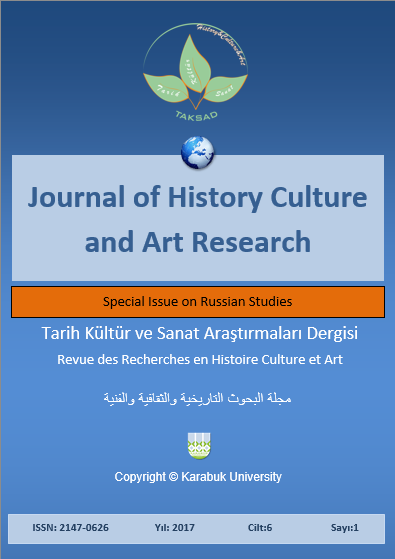Mercenaries in the Army of Hellenistic Athens
DOI:
https://doi.org/10.7596/taksad.v6i5.1293Keywords:
History, Athens, Armed forces, Mercenaries, Tarentians.Abstract
This article interests in history of armed forces of the antiquity states, their structure, deployment order, the organization of command, evolution of arms, policy strokes, action of armies in the military conflicts, and to their use in internal political fight, as well as to involvement of mercenaries. During the Classical Period of Greek history big fame was gained by armed forces of Athens and Sparta. Athens in the 5th century BC was at the peak of power and pursued active foreign policy which was in many respects supported by powerful army and fleet. The reason of traditionally high interest in history of Athens of the Classical Period including the armed forces history of the polis also lies in it. However Athens and their armed forces suffered a serious loss and got beaten in the Peloponnese war and the final decline of political and military power of Athens occurred after defeat in Lamian war therefore military activity of the polis sharply decreases. Therefore the history of Hellenistic period Athens gets much less attention. Proceeding from it, the purpose of article consists in a research of the role of mercenaries in armed forces of Athens in the period of Hellenism. The leading method of this research is the comparative-historical method allowing tracking mercenaries hire by Athens during the specified period on the basis of a complex sources use. The main research results consist in identification of an order and features of the hired contingents use, their places in armed forces of the polis. Materials of article can be useful to the further scientific research regarding the history of Athens and military ancient history as well as to creating educational and handbooks on this perspective.
References
Bayliss, A. J. (2004). New Readings on a List of Mercenaries from Athens. Zeitschrift für Papyrologie und Epigraphik, 146, 85-90.
Bettalli, M. (2013). Mercenari. Il mestiere delle armi nel mondo greco antico. Roma: Carocci.
Bing, J. D. (1977). Lykopodes: A Contribution to Athenian Military History from Peisistratus to Cleisthenes. Classical Journal, 72(4), 308-316.
Bugh, G. R. (1982). Andocides, Aeschines, and the Three Hundred Athenian Cavalrymen. Phoenix, 36(4), 306-312.
Bugh, G. R. (1988). The Horsemen of Athens. Princeton: Princeton University Press.
Bugh, G. R. (2011). The Tarentine Cavalry in the Hellenistic Period: Ethnic or Technic? Pratiques et identités culturelles des armées héllénistiques du monde mediterraneen, (pp. 285-294) Bordeaux: Ausonius.
Camp, J. McK (1996). Excavations in the Athenian Agora: 1994 and 1995. Hesperia, 65(3), 231-261.
Chaniotis, A. (2005). War in the Hellenistic World. A Social and Cultural History. Malden, MA and Oxford: Blackwell Publishing.
Dreyer, B. (1999). Untersuchungen zur Geschichte des spätklassischen Athen (322 ca 230 v. Chr.). Stuttgart: Franz Steiner Verlag.
Engels, S. (2012). Mercenaries in the Classical World. To the Death of Alexander. Barnsley: Pen & Sword Military.
Ferguson, W. S. (1912). Hellenistic Athens. London.
Ferguson, W. S. (1929). Lachares and Demetrius Poliorcetes. Classical Philology, 24(1), 1-31.
Fields, N. (2008). Tarentine Horseman of Magna Graecia: 430-190 B.C. London: Osprey Publishing.
Frolov, E. D. (2001). Greece during an era of late classics. St. Petersburg: Humanitarian Academy Center.
Gabbert, J. J. (1997). Antigonus II Gonatas: A Political Biography. London: Routledge.
Griffith, G. T. (1935). The Mercenaries of the Hellenistic World. Cambridge: Cambridge University Press.
Habicht, C. (1992). Athens and the Ptolemies. Classical Antiquity, 11(1), 68-90.
Habicht, C. (1999). Athens. City history during the Hellenistic era. Trans by. Y. G. Vinogradova. Moscow: Science.
Landucci Gattinoni, F. (1995). Mercenari nella politica ateniese dell’ età di Alessandro. Ancient Society, 26, 59-91.
Leslie-Shear, Jr. T. (1978). Kallias of Sphettos and the Revolt of Athens. Hesperia, 17. Princeton, New Jersey.
Marinovich, L. P. (1968). Mercenaries during the Peloponnese war. The Messenger of ancient history, 4, 70-90.
Marinovich, L. P. (1975). Greek mercenarism of the 4th century BC and crisis of the polis. Moscow: Science.
Marinovich, L. P. (1990). End of classical Greece (Lamian war). Hellenism: economy, policy, culture, (pp. 103-140). Moscow: Science.
Nefedkin, A. K. (2005). A cavalry of the Hellenistic Athens. The Bulletin of St. Petersburg State University, 2(3), 138-141.
Nefedkin, A. K. (2006). Tarentine riders in the Hellenistic armies. The Classical antiquity and archeology, 12, 109-117.
Parke, H. W. (1933). Greek mercenary soldiers. Oxford: Clarendon Press.
Post, L. A. (1930). Note on Oxyrhynchus Papyrus XVII, 2082. Classical Philology, 25(2), 183-184.
Rhodes, P. J. (2010). The Literary and Epigraphic Evidence. A Companion to Ancient Macedonia, (pp. 23-40). Chichester: Wiley-Blackwell.
Spence, I. G. (1993). The Cavalry of Classical Greece. Oxford: Clarendon Press.
Stevens, G. P. (1961). Concerning the Parthenos. Hesperia, 30(1), 1-7.
Thonemann, P. J. (2003). Charias on the Acropolis. Zeitschrift für Papyrologie und Epigraphik, 144, 123-124.
Trundle, M. (2004). Greek Mercenaries: From the Late Archaic Period to Alexander. London and New York.
Downloads
Published
How to Cite
Issue
Section
License
All papers licensed under Creative Commons 4.0 CC-BY.- Share — copy and redistribute the material in any medium or format
- Adapt — remix, transform, and build upon the material for any purpose, even commercially.
Under the following terms:
Attribution — You must give appropriate credit, provide a link to the license, and indicate if changes were made. You may do so in any reasonable manner, but not in any way that suggests the licensor endorses you or your use.
- No additional restrictions — You may not apply legal terms or technological measures that legally restrict others from doing anything the license permits.







